R For SNA
Workshop 2
Eric Brewe
Associate Professor of Physics at Drexel University
11 August 2020, last update: 2020-08-10
Welcome Back!
Workshop #1 was a sprint!
This should be a bit more reasonably paced.
First of all, we will not need to build the network all over again.
But we should start with some project-oriented workflow.
The blog post by Jenny Bryan linked above describes the basic logic for a project orinted workflow.
Each project gets:
- It's own folder
- A project file (which you never open)
- As many Rmarkdown or R script files as needed
- Subfolders for:
- data
- plots
- reports/papers etc.
Let's build on our project oriented workflow
Our project is about building and analyzing the Workshop network
So we will not need a new project folder, we will continue to use RForSNA, which you should have set up in WS1.
This time we will add a new .Rmd file, give it a title like "node_properties.Rmd"
So navigate to your RForSNA file and create a new .Rmd file.
Then, add a code chunk to load the libraries necessary and run this chunk.
library(tidyverse) #tools for cleaning data library(igraph) #package for doing network analysislibrary(tidygraph) #tools for doing tidy networkslibrary(here) #tools for project-based workflowlibrary(ggraph) #plotting tools for networksLet's load our data
This workshop assumes you did the work from week 1 and you know how to install libraries, read csv files into data, and to manipulate data in R.
The benefit of having done the work previously is that we don't have to re-do it (unless we want to change something)
So I took the network at the end of workshop #1 and saved it as a .rds file. I could have saved it as a pair of csv files and rebuilt the network, but if I save as rds it will be ready to go!
To load an rds file the syntax is a little different:
gr <- readRDS(here("data", "WokshopNetwork.rds"))Let's inspect our data
gr## # A tbl_graph: 60 nodes and 101 edges## ### # A directed multigraph with 8 components## ### # Node Data: 60 x 4 (active)## name AMPM Dessert Pages## <chr> <chr> <chr> <dbl>## 1 5106 morning person. Brownies 350## 2 6633 morning person. I don't care for dessert. 12## 3 7599 night owl. Ice Cream 300## 4 4425 morning person. I don't care for dessert. 0## 5 2495 morning person. Brownies 264## 6 6355 night owl. Ice Cream 4## # … with 54 more rows## ### # Edge Data: 101 x 2## from to## <int> <int>## 1 1 1## 2 2 35## 3 3 14## # … with 98 more rowsLet's plot it quickly
Which node is the most important?
```rgr %>% ggraph(layout = "kk") + geom_edge_link() + geom_node_point(aes(color = Dessert)) + theme(legend.position="bottom")```
Let's explore centrality
One view of importance is how many people you are connected to.
- Degree = number of edges a node is involved in.
- In Degree = number of incoming edges
- Out Degree = number of outgoing edges
Lets calculate degree
gr %>% activate(nodes) %>% mutate(deg = centrality_degree(mode = "total")) %>% arrange(desc(deg)) -> grgr## # A tbl_graph: 60 nodes and 101 edges## ### # A directed multigraph with 8 components## ### # Node Data: 60 x 5 (active)## name AMPM Dessert Pages deg## <chr> <chr> <chr> <dbl> <dbl>## 1 7743 morning person. Ice Cream 300 14## 2 2921 morning person. Ice Cream 426 12## 3 1386 night owl. Ice Cream 500 11## 4 7040 morning person. I don't care for dessert. 400 9## 5 9929 morning person. Brownies 527 8## 6 5051 night owl. Ice Cream 240 8## # … with 54 more rows## ### # Edge Data: 101 x 2## from to## <int> <int>## 1 28 28## 2 43 32## 3 29 10## # … with 98 more rowsLet's use the degree in a plot
```rgr %>% ggraph(layout = "kk") + geom_edge_link() + geom_node_point(aes(size = deg )) + theme(legend.position="bottom")```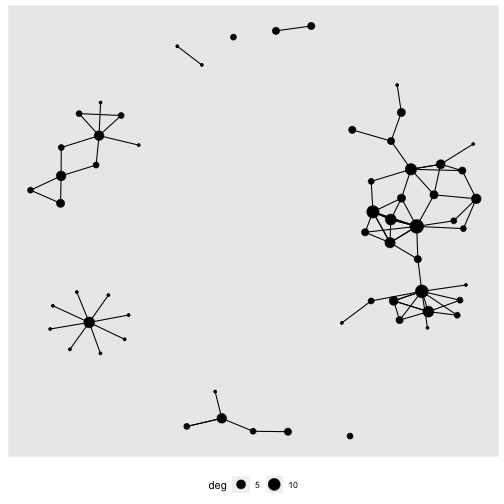
Let's see about just In-degree
gr %>% activate(nodes) %>% mutate(InDeg = centrality_degree(mode = "in")) %>% arrange(desc(InDeg)) -> grgr## # A tbl_graph: 60 nodes and 101 edges## ### # A directed multigraph with 8 components## ### # Node Data: 60 x 6 (active)## name AMPM Dessert Pages deg InDeg## <chr> <chr> <chr> <dbl> <dbl> <dbl>## 1 5844 <NA> <NA> NA 8 8## 2 7743 morning person. Ice Cream 300 14 5## 3 1386 night owl. Ice Cream 500 11 4## 4 2169 <NA> <NA> NA 4 4## 5 4755 <NA> <NA> NA 4 4## 6 9929 morning person. Brownies 527 8 3## # … with 54 more rows## ### # Edge Data: 101 x 2## from to## <int> <int>## 1 38 38## 2 51 20## 3 39 15## # … with 98 more rowsLet's use in degree in our plot
```rgr %>% ggraph(layout = "kk") + geom_edge_link() + geom_node_point(aes(size = InDeg )) + theme(legend.position="bottom")```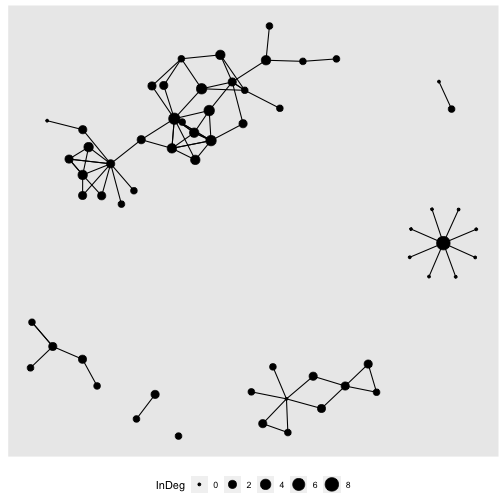
Lets compare centrality plots.
You might have noticed, the plots change layouts
To address this we set a layout...
```rGrLayout = create_layout(gr, layout = "kk")ggraph(GrLayout) + geom_edge_link() + geom_node_point(aes(size = InDeg)) + theme(legend.position="bottom")```The only issue is, we then can't change nodes/attributes.
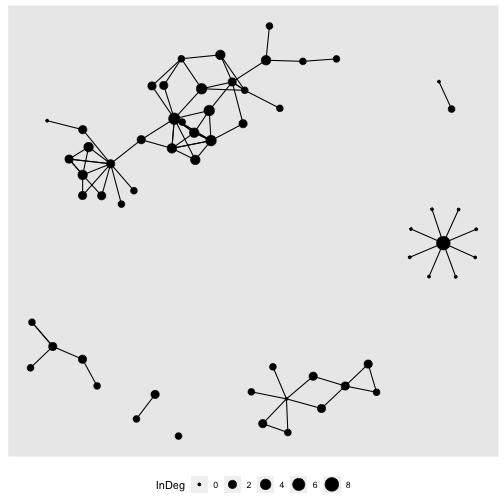
Let's compare in-degree and out-degree
ggraph(GrLayout) + geom_edge_link() + geom_node_point(aes(size = InDeg)) + theme(legend.position="bottom")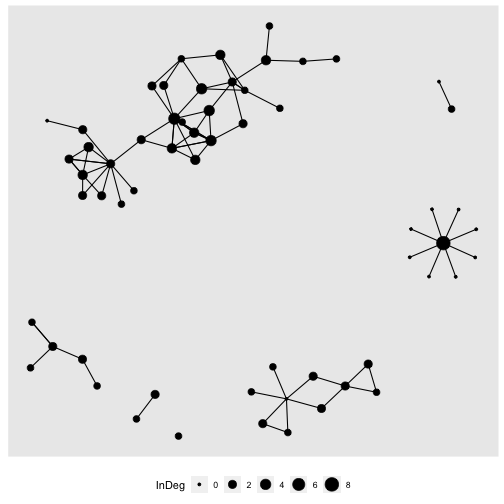
ggraph(GrLayout) + geom_edge_link() + geom_node_point(aes(size = deg)) + theme(legend.position="bottom")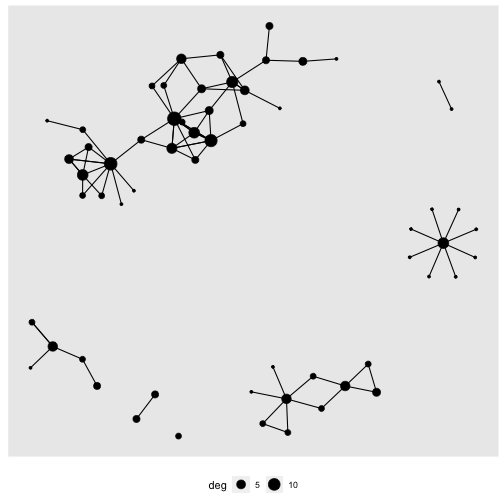
Let's explore some other centrality measures
Here is a list of all of the centrality measures that you have access to in tidygraph:
http://finzi.psych.upenn.edu/R/library/tidygraph/html/centrality.html
This is a workshop and thus far I've done most of the work! It is your turn!
- I will randomly assign people to breakout rooms.
- As a group, choose one of the centrality measures from the list.
- Calculate the centrality measure, use it in the plotting recipe we've been using, and be ready to describe what you think this centrality metric measures.
- You will have 10-15 minutes.
Let's use centrality in hypothesis testing
We should establish a research question. How about:
Are morning people or night owls more central in our network?
To test this we might use:
- An independent samples t-test to see if the means of a centrality metric is different.
- A linear model to explore the relationships between the grouping variable and the outcome variable.
Either way, we need to choose a centrality metric.
Our winner...centrality_eigen!
Let's first calculate and plot eigenvector centrality
Eigenvector centrality is interesting because it allows a node to inherit centrality from neighbors. It works with weighted networks, and but it treats directed networks as undirected.
We want to calculate eigenvector centrality, then add it as an attribute to our graph, and add it to our layout dataframe.
gr %>% activate(nodes) %>% mutate(CentE = centrality_eigen()) %>% arrange(desc(CentE)) -> gr#This makes a dataframe of names and CentEgr %>% activate(nodes) %>% select(name, CentE) %>% as_tibble()-> CentEdf#This adds it to the GrLayout dataframe.GrLayout = left_join(GrLayout, CentEdf, by = "name")Let's plot with eigenvector centrality
```rggraph(GrLayout) + geom_edge_link() + geom_node_point(aes(size = CentE)) + theme(legend.position="bottom")```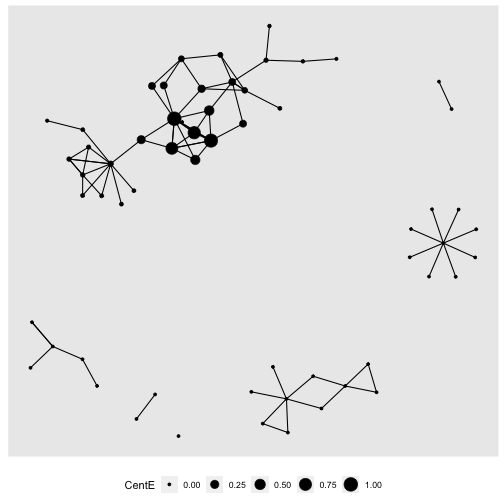
Cool, different nodes are important!
Let's get ready to use in linear model
First, let's see how it is distributed
```rgr %>% select(AMPM,CentE) %>% as_tibble() %>% ggplot(., aes(x = CentE)) + geom_histogram()```Not Normal!
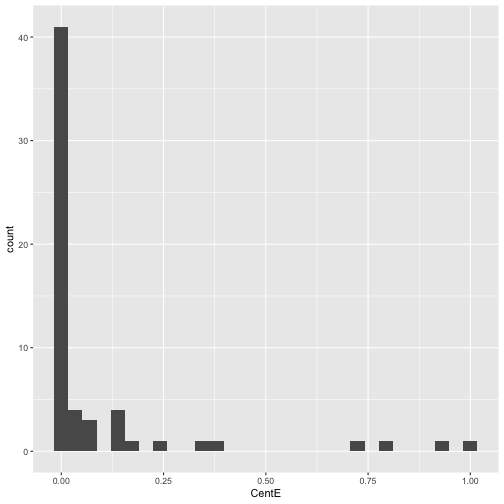
Let's reflect
Remember when I said...
Let's reflect
Remember when I said...
"Nodes and interactions are interdependent*"
and
Let's reflect
Remember when I said...
"Nodes and interactions are interdependent*"
and
"* Violates basic assumption of inferential statistics"
Let's reflect
Remember when I said...
"Nodes and interactions are interdependent*"
and
"* Violates basic assumption of inferential statistics"
Well, this is the problem, because network metrics are interdependent, they are invariably not normally distributed. Which means we have to take some additional precautions about how we use them in hypothesis testing. Which means...
Let's reflect
Remember when I said...
"Nodes and interactions are interdependent*"
and
"* Violates basic assumption of inferential statistics"
Well, this is the problem, because network metrics are interdependent, they are invariably not normally distributed. Which means we have to take some additional precautions about how we use them in hypothesis testing. Which means... Bootstrapping!
I said it here: https://ericbrewe.com/slides/rforsna/rforsna_ws1.html#8
Let's get ready to bootstrap
What is bootstrapping?
Bootstrapping is a resampling method, where you draw samples based on your existing dataset, calculate your measure of interest, store this, and then rinse and repeat.
Let's get ready to bootstrap
What is bootstrapping?
Bootstrapping is a resampling method, where you draw samples based on your existing dataset, calculate your measure of interest, store this, and then rinse and repeat.
R has a package for that.
Let's get ready to bootstrap
What is bootstrapping?
Bootstrapping is a resampling method, where you draw samples based on your existing dataset, calculate your measure of interest, store this, and then rinse and repeat.
R has a package for that.
Let's install the package "boot" and load it.
```rinstall.packages("boot")library(boot)```Let's set up a bootstrapped model
Our goal was to answer the question, "Are morning people or night owls more central in our network?"
So we will run a bootstrapped linear model to look at this relationship.
First, get our data and assign it to its own dataframe (you don't have to, but.)
GrLayout %>% select(AMPM,CentE) -> LmDataLet's set up a bootstrapped model
Our goal was to answer the question, "Are morning people or night owls more central in our network?"
So we will run a bootstrapped linear model to look at this relationship.
First, get our data and assign it to its own dataframe (you don't have to, but.)
GrLayout %>% select(AMPM,CentE) -> LmDataNext, we need to define the linear model as a function. Why? I'll explain in next slide.
bs <- function(formula, data, indices) { d <- data[indices,] fit <- lm(formula, data = d) return(coef(fit))}Let's run this linear model
Finally, we use the boot command to call the function
Since we want to run this once, and keep our results around, we should do two things.
- Set our seed so that we can replicate if need be.
- Assign our results to a data structure.
set.seed(327)results <- boot(data = LmData, statistic = bs, R = 50, formula = CentE ~ AMPM)Let's explore the results
First, what is the result if we don't use bootstrapping?
lm(CentE ~ AMPM, data = LmData)## ## Call:## lm(formula = CentE ~ AMPM, data = LmData)## ## Coefficients:## (Intercept) AMPMnight owl. ## 0.121912 -0.003964Now, what about the bootstrap?
results## ## ORDINARY NONPARAMETRIC BOOTSTRAP## ## ## Call:## boot(data = LmData, statistic = bs, R = 50, formula = CentE ~ ## AMPM)## ## ## Bootstrap Statistics :## original bias std. error## t1* 0.121911858 0.009475059 0.05578382## t2* -0.003963586 -0.019188955 0.07939136boot.ci(results, type = "basic")## BOOTSTRAP CONFIDENCE INTERVAL CALCULATIONS## Based on 50 bootstrap replicates## ## CALL : ## boot.ci(boot.out = results, type = "basic")## ## Intervals : ## Level Basic ## 95% (-0.0285, 0.2213 ) ## Calculations and Intervals on Original Scale## Some basic intervals may be unstableLet's figure out what this means
- Original is the estimate without resampling.
- Bias is the difference between the bootstrap mean and the original.
- t1* is the intercept
- t2* is the coefficient for the AMPM variable
The confidence interval on the coefficients are (-0.0285, 0.2213)
So, are morning people more central than night owls?
Probabaly not
😞